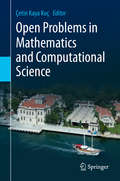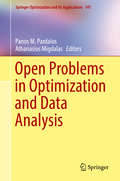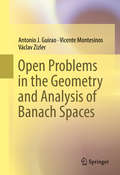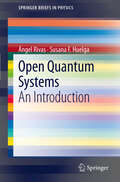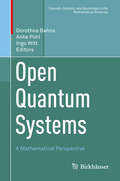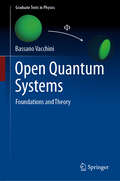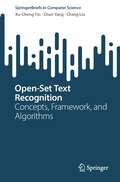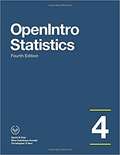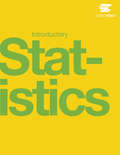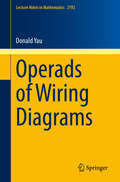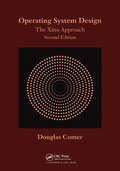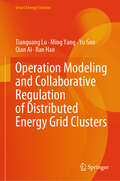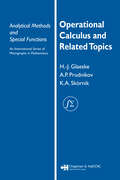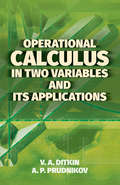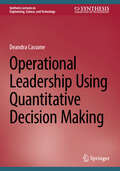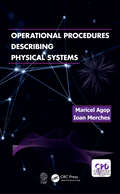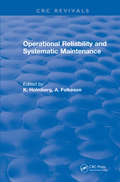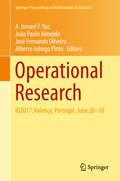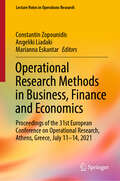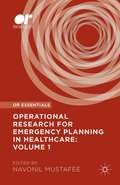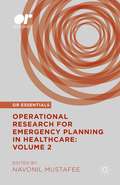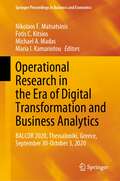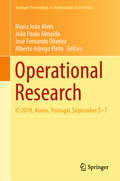- Table View
- List View
Open Problems in Mathematics and Computational Science
by Çetin Kaya KoçThis book presents interesting, important unsolved problems in the mathematical and computational sciences. The contributing authors are leading researchers in their fields and they explain outstanding challenges in their domains, first by offering basic definitions, explaining the context, and summarizing related algorithms, theorems, and proofs, and then by suggesting creative solutions. The authors feel a strong motivation to excite deep research and discussion in the mathematical and computational sciences community, and the book will be of value to postgraduate students and researchers in the areas of theoretical computer science, discrete mathematics, engineering, and cryptology.
Open Problems in Optimization and Data Analysis (Springer Optimization and Its Applications #141)
by Panos M. Pardalos Athanasios MigdalasComputational and theoretical open problems in optimization, computational geometry, data science, logistics, statistics, supply chain modeling, and data analysis are examined in this book. Each contribution provides the fundamentals needed to fully comprehend the impact of individual problems. Current theoretical, algorithmic, and practical methods used to circumvent each problem are provided to stimulate a new effort towards innovative and efficient solutions. Aimed towards graduate students and researchers in mathematics, optimization, operations research, quantitative logistics, data analysis, and statistics, this book provides a broad comprehensive approach to understanding the significance of specific challenging or open problems within each discipline. The contributions contained in this book are based on lectures focused on “Challenges and Open Problems in Optimization and Data Science” presented at the Deucalion Summer Institute for Advanced Studies in Optimization, Mathematics, and Data Science in August 2016.
Open Problems in the Geometry and Analysis of Banach Spaces
by Vicente Montesinos Václav Zizler Antonio J. GuiraoThis is an collection of some easily-formulated problems that remain open in the study of the geometry and analysis of Banach spaces. Assuming the reader has a working familiarity with the basic results of Banach space theory, the authors focus on concepts of basic linear geometry, convexity, approximation, optimization, differentiability, renormings, weak compact generating, Schauder bases and biorthogonal systems, fixed points, topology and nonlinear geometry. The main purpose of this work is to help in convincing young researchers in Functional Analysis that the theory of Banach spaces is a fertile field of research, full of interesting open problems. Inside the Banach space area, the text should help expose young researchers to the depth and breadth of the work that remains, and to provide the perspective necessary to choose a direction for further study. Some of the problems are longstanding open problems, some are recent, some are more important and some are only local problems. Some would require new ideas, some may be resolved with only a subtle combination of known facts. Regardless of their origin or longevity, each of these problems documents the need for further research in this area.
Open Quantum Systems
by Ángel Rivas Susana F. HuelgaIn this volume the fundamental theory of open quantum systems is revised in the light of modern developments in the field. A unified approach to the quantum evolution of open systems is presented by merging concepts and methods traditionally employed by different communities, such as quantum optics, condensed matter, chemical physics and mathematical physics. The mathematical structure and the general properties of the dynamical maps underlying open system dynamics are explained in detail. The microscopic derivation of dynamical equations, including both Markovian and non-Markovian evolutions, is also discussed. Because of the step-by-step explanations, this work is a useful reference to novices in this field. However, experienced researches can also benefit from the presentation of recent results.
Open Quantum Systems: A Mathematical Perspective (Tutorials, Schools, and Workshops in the Mathematical Sciences)
by Dorothea Bahns Anke Pohl Ingo WittThis book presents four survey articles on various aspects of open quantum systems, specifically addressing quantum Markovian processes, Feller semigroups and nonequilibrium dynamics. The contributions are based on lectures given by distinguished experts at a summer school in Göttingen, Germany. Starting from basic notions, the authors of these lecture notes accompany the reader on a journey up to the latest research, highlighting new challenges and addressing unsolved problems at the interface between mathematics and physics. Though the book is primarily addressed to graduate students, it will also be of interest to researchers.
Open Quantum Systems: Foundations and Theory (Graduate Texts in Physics)
by Bassano VacchiniThe proposed book is a bridge between the foundations of quantum mechanics and the theory of open quantum systems. The treatment of open quantum systems is a rapidly growing subject, of interest to an ever-increasing number of scientists. The main focus is on overcoming the idealization of perfect isolation of a quantum system, so as to allow for a more realistic treatment and to provide the relevant background for the development of quantum technologies. The book is addressed to students and researchers in the field of open quantum systems and more generally quantum mechanics, a wide community of physicists, mathematicians, and chemists. It is devised both to enter the field and to prepare a series of lectures or a one-semester course on the topic.
Open-Set Text Recognition: Concepts, Framework, and Algorithms (SpringerBriefs in Computer Science)
by Chang Liu Xu-Cheng Yin Chun YangIn real-world applications, new data, patterns, and categories that were not covered by the training data can frequently emerge, necessitating the capability to detect and adapt to novel characters incrementally. Researchers refer to these challenges as the Open-Set Text Recognition (OSTR) task, which has, in recent years, emerged as one of the prominent issues in the field of text recognition. This book begins by providing an introduction to the background of the OSTR task, covering essential aspects such as open-set identification and recognition, conventional OCR methods, and their applications. Subsequently, the concept and definition of the OSTR task are presented encompassing its objectives, use cases, performance metrics, datasets, and protocols. A general framework for OSTR is then detailed, composed of four key components: The Aligned Represented Space, the Label-to-Representation Mapping, the Sample-to-Representation Mapping, and the Open-set Predictor. In addition,possible implementations of each module within the framework are discussed. Following this, two specific open-set text recognition methods, OSOCR and OpenCCD, are introduced. The book concludes by delving into applications and future directions of Open-set text recognition tasks.This book presents a comprehensive overview of the open-set text recognition task, including concepts, framework, and algorithms. It is suitable for graduated students and young researchers who are majoring in pattern recognition and computer science, especially interdisciplinary research.
OpenIntro Statistics
by David Diez Mine Çetinkaya-Rundel Christopher BarrBlack and white paperback edition, with this new edition released in May 2019. <p><p> The OpenIntro project was founded in 2009 to improve the quality and availability of education by producing exceptional books and teaching tools that are free to use and easy to modify. Our inaugural effort is OpenIntro Statistics. Probability is optional, inference is key, and we feature real data whenever possible. Files for the entire book are freely available at openintro.org, and anybody can purchase a paperback copy from amazon.com for about $20. <p> OpenIntro has grown through the involvement and enthusiasm of our community. Visit our website, openintro.org. We provide videos, labs for R and SAS, teaching resources like slides, and many other helpful resources.
OpenStat Reference Manual
by William MillerThis reference manual for the OpenStat software, an open-source software developed by William Miller, covers a broad spectrum of statistical methods and techniques. A unique feature is its compatibility with many other statistical programs. OpenStat users are researchers and students in the social sciences, education, or psychology, who benefit from the hands on approach to Statistics. During and upon completion of courses in Statistics or measurement, students and future researchers need a low cost computer program available to them, and OpenStat fills this void. The software is used in Statistics courses around the world with over 50,000 downloads per year. The manual covers all functions of the OpenStat software, including measurement, ANOVAS, regression analyses, simulations, product-moment and partial correlations, and logistic regression. The manual is an important learning tool that explains the Statistics behind the many analyses possible with the program and demonstrates these analyses.
OpenStax for Introductory Statistics
by Barbara Illowsky Susan DeanIntroductory Statistics provides an engaging, practical, and thorough overview of the core concepts and skills taught in most one-semester statistics courses. The text focuses on diverse applications from a variety of fields and societal contexts, including business, healthcare, sciences, sociology, political science, computing, and several others. The material supports students with conceptual narratives, detailed step-by-step examples, and a wealth of illustrations, as well as collaborative exercises, technology integration problems, and statistics labs. The text assumes some knowledge of intermediate algebra, and includes thousands of problems and exercises that offer instructors and students ample opportunity to explore and reinforce useful statistical skills.
Opening up the Debate on the Aging Society: Preliminary Hypotheses for a Possible Mutational and Post-mutationary Society (International Perspectives on Aging #34)
by Alejandro KleinThis book documents, verifies and brings to life the issues and debates that are created around the aging society. It carefully offers a series of opinions that attempt to illuminate the fact that the aging society goes beyond aging and includes a series of changes in terms of family, social ties, relationships, and the way human beings perceive society. The book contributes substantially to the discussion of this new type of aging, the new types of families, and the new types of relationships, as well as in the application of cutting-edge analytical strategies to understand the trends and patterns of these new modes of social structures. The book includes detailed perspectives on how decisions need to be made, mindsets need to be changed, and precautions need to be taken to positively deal with these new realities. The evidence presented in this book suggests that if this does not happen, the danger of thanato-politics appears, which, denying reality, will lead humanity into difficult labyrinths, perhaps without any "Ariadne's thread" that will allow a glimpse of the way out. The translation from Spanish to English was done with the help of artificial intelligence (machine translation by the service DeepL.com). A subsequent human revision was done primarily in terms of content.
Operads of Wiring Diagrams (Lecture Notes in Mathematics #2192)
by Donald YauWiring diagrams form a kind of graphical language that describes operations or processes with multiple inputs and outputs, and shows how such operations are wired together to form a larger and more complex operation. This monograph presents a comprehensive study of the combinatorial structure of the various operads of wiring diagrams, their algebras, and the relationships between these operads.The book proves finite presentation theorems for operads of wiring diagrams as well as their algebras. These theorems describe the operad in terms of just a few operadic generators and a small number of generating relations. The author further explores recent trends in the application of operad theory to wiring diagrams and related structures, including finite presentations for the propagator algebra, the algebra of discrete systems, the algebra of open dynamical systems, and the relational algebra. A partial verification of David Spivak’s conjecture regarding the quotient-freeness of the relational algebra is also provided. In the final part, the author constructs operad maps between the various operads of wiring diagrams and identifies their images. Assuming only basic knowledge of algebra, combinatorics, and set theory, this book is aimed at advanced undergraduate and graduate students as well as researchers working in operad theory and its applications. Numerous illustrations, examples, and practice exercises are included, making this a self-contained volume suitable for self-study.
Operating System Design: The Xinu Approach, Second Edition
by Douglas ComerAvoiding the typical black box approach found in other operating system textbooks, this bestselling book explains how to build an operating system from the ground up. It removes the mystery from operating system design and consolidates the body of material into a systematic discipline. The text presents a hierarchical design paradigm that organizes major operating system components in an orderly, understandable manner. This second edition has been completely rewritten with updated code throughout and examples for two low-cost experimenter boards.
Operation Modeling and Collaborative Regulation of Distributed Energy Grid Clusters (Smart Energy Systems)
by Ming Yang Yu Guo Tianguang Lu Qian Ai Ran HaoThis book delves into modeling, multi-cluster interactive dispatch, and multi-energy coordination in distributed energy grid clusters, focusing on the integrated operation and scheduling of electricity, heating, and gas systems. It introduces innovative methods such as physical information fusion, multi-energy system modeling, and cloud-edge collaborative computing. Through numerous case studies and simulations, it validates strategies like hierarchical control, rolling optimization, and real-time adjustments. The book also explores market trading strategies using game theory and competitive pricing models. It concludes with an analysis of the technological trends and challenges facing distributed energy networks, serving as a reference for researchers, engineers, and graduate students in the energy internet field.
Operational Calculus and Related Topics (Analytical Methods and Special Functions)
by A. P. Prudnikov K.A. SkórnikEven though the theories of operational calculus and integral transforms are centuries old, these topics are constantly developing, due to their use in the fields of mathematics, physics, and electrical and radio engineering. Operational Calculus and Related Topics highlights the classical methods and applications as well as the recent advan
Operational Calculus in Two Variables and Its Applications (Dover Books on Mathematics)
by A. P. Prudnikov V. A. DitkinA concise monograph by two Russian experts provides an account of the operational calculus in two variables based on the two-dimensional Laplace transform. Suitable for advanced undergraduates and graduate students in mathematics, the treatment requires some familiarity with operational calculus in one variable.Part One of the two-part approach presents the fundamental theory in two chapters, examining the two-dimensional Laplace transform and offering basic definitions and theorems of the operational calculus in two variables and its applications. Part Two presents tables of formulae for various categories of functions, including rational and irrational functions; exponential and logarithmic functions; cylinder, integral, and confluent hypergeometric functions; and other areas.
Operational Leadership Using Quantitative Decision Making (Synthesis Lectures on Engineering, Science, and Technology)
by Deandra CassoneThis book focuses on analytical and quantitative methods that align improvement opportunities with organizational goals and metrics. The book describes a framework that starts with developing a holistic view of an organization and then defining the organization’s goals, objectives, decision criteria, and metrics to result in meaningful measures for process, project, and product investment decisions. The author describes how to utilize decision-making tools, analytical methods, and optimization techniques to enhance the objectivity and robustness of the readers’ decisions. This framework supports the use of these tools and enables readers to make decisions that drive bottom-line performance. Aspects of this approach have been used in corporate, military, and government agencies to drive the efficient use of available resources.
Operational Procedures Describing Physical Systems
by Ioan Merches Marciel AgopThe authors examine topics in modern physics and offer a unitary and original treatment of the fundamental problems of the dynamics of physical systems, as well as a description of the nuclear matter within a framework of general relativity. They show that some physical phenomena studied at two different resolution scales (e.g. microscale, cosmological scale), apparently with no connection between them, become compatible by means of the operational procedures, acting either as some ”hidden” symmetries, or harmonic-type mappings. The book is addressed to the students, researchers and university/high school teachers working in the fields of mathematics, physics, and chemistry.
Operational Reliability and Systematic Maintenance
by K. HolmbergScientists from four countries cooperated in a reseach effort aimed at the imporvement of operational reliability via innovations in design and testing and systematic maintenance. The scientists had varied backgrounds ranging from mathematic to applied mechanical engineering, and the results fo this effort are documented in this book.
Operational Research
by João Paulo Almeida José Fernando Oliveira Alberto Adrego Pinto A. Ismael VazThis proceedings book presents selected contributions from the XVIII Congress of APDIO (the Portuguese Association of Operational Research) held in Valença on June 28–30, 2017. Prepared by leading Portuguese and international researchers in the field of operations research, it covers a wide range of complex real-world applications of operations research methods using recent theoretical techniques, in order to narrow the gap between academic research and practical applications. Of particular interest are the applications of, nonlinear and mixed-integer programming, data envelopment analysis, clustering techniques, hybrid heuristics, supply chain management, and lot sizing and job scheduling problems. In most chapters, the problems, methods and methodologies described are complemented by supporting figures, tables and algorithms.The XVIII Congress of APDIO marked the 18th installment of the regular biannual meetings of APDIO – the Portuguese Association of Operational Research. The meetings bring together researchers, scholars and practitioners, as well as MSc and PhD students, working in the field of operations research to present and discuss their latest works. The main theme of the latest meeting was Operational Research Pro Bono. Given the breadth of topics covered, the book offers a valuable resource for all researchers, students and practitioners interested in the latest trends in this field.
Operational Research Methods in Business, Finance and Economics: Proceedings of the 31st European Conference on Operational Research, Athens, Greece, July 11-14, 2021 (Lecture Notes in Operations Research)
by Constantin Zopounidis Angeliki Liadaki Marianna EskantarThis book gathers selected high-quality papers presented at the 31st European Conference on Operational Research, which was held in Athens, Greece on June 11-14, 2021.It highlights the latest advances in the application of operations research (OR) to technology-driven areas in business, finance, and economics, covering both theoretical and methodological developments, as well as real-world case studies. It also explores the connections between OR and other analytical disciplines, such as soft computing and computer science, which can promote the development of new decision support technologies.
Operational Research for Emergency Planning in Healthcare: Volume 1 (OR Essentials)
by Navonil MustafeeThis book presents a collection of studies that have applied analytical methods to improve preparedness, planning, and a faster response to A&E and public health emergencies like epidemic and disease outbreak. It explores the application of quantitative Operational Research techniques such as Mathematical Modelling and Optimization, Maximum Likelihood Estimation, Multiple-Criteria Decision Analysis, Discrete-event Simulation, Data Mining, and Bayesian Decision Models. These techniques have been used for better management of emergency care, including first responders, ambulance services, A&E departments, and mass immunisation centres. This volume focuses on planning at the operational level whereas volume 2 focuses mainly on planning at the strategic level. The OR Essentials series presents a unique cross-section of high quality research work fundamental to understanding contemporary issues and research across a range of Operational Research (OR) topics. It brings together some of the best research papers from the highly respected journals of the Operational Research Society, also published by Palgrave Macmillan.
Operational Research for Emergency Planning in Healthcare: Volume 2 (OR Essentials)
by Maysaa Husam JaberThis book presents a selection of studies that have applied Operational Research methods to improve emergency planning in healthcare, to include both A&E and public health emergencies like epidemic and natural disasters. The studies have delved into qualitative Operational Research like Problem Structuring, Critical Systems Thinking, Soft Systems Methodology, and Qualitative System Dynamics, and also quantitative techniques such as Monte Carlo Simulation, Discrete-event Simulation, and System Dynamics. These techniques have been applied for review and assessment of emergency services, for policy formulation and for facilitating broader public engagement in emergency preparedness and response. Furthermore, this book presents rigorous reviews on the applications of Operational Research in the wider healthcare context. This volume focuses mainly on emergency planning at the strategic level, whereas volume 1 focuses on planning at the operational level. The OR Essentials series presents a unique cross-section of high quality research work fundamental to understanding contemporary issues and research across a range of Operational Research (OR) topics. It brings together some of the best research papers from the highly respected journals of the Operational Research Society, also published by Palgrave Macmillan.
Operational Research in the Era of Digital Transformation and Business Analytics: BALCOR 2020, Thessaloniki, Greece, September 30-October 3, 2020 (Springer Proceedings in Business and Economics)
by Nikolaos F. Matsatsinis Fotis C. Kitsios Michael A. Madas Maria I. KamariotouThis proceedings volume presents new methods and applications in Operational Research and Management Science with a special focus on Business Analytics. Featuring selected contributions from the XIV Balkan Conference on Operational Research held in Thessaloniki, Greece in 2020 (BALCOR 2020), it addresses applications and methodological tools or techniques in various areas of Operational Research, such as agent-based modelling, big data and business analytics, data envelopment analysis, data mining, decision support systems, fuzzy systems, game theory, heuristics, metaheuristics and nature inspired optimization algorithms, linear and nonlinear programming, machine learning, multiple criteria decision analysis, network design and optimization, queuing theory, simulation and statistics.
Operational Research: IO 2018, Aveiro, Portugal, September 5-7 (Springer Proceedings in Mathematics & Statistics #278)
by Maria João Alves João Paulo Almeida José Fernando Oliveira Alberto Adrego PintoThis book gathers selected contributions by top Portuguese and international researchers in the field of Operations Research, presented at the 19th Congress of APDIO (Portuguese Association of Operational Research). The papers address a broad range of complex real-world problems, which are approached using recent theoretical techniques. Of particular interest are the applications of e.g. linear, nonlinear and mixed-integer programming, multiobjective optimization, metaheuristics and hybrid heuristics, multicriteria decision analysis, data envelopment analysis, clustering techniques and decision support systems, in such varied contexts as: supply chain management, scheduling problems, production management, logistics, energy, finance and healthcare. This conference, organized by APDIO and held in Aveiro, Portugal in September 2018, offered an ideal opportunity to discuss the latest developments in this field and to build new bridges between academic researchers and practitioners. Summarizing the outcomes, this book offers a valuable tool for all researchers, students and practitioners who wish to learn about the latest trends in this field.
